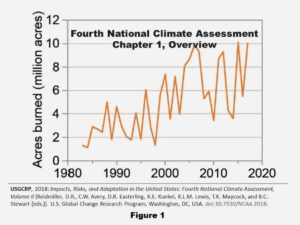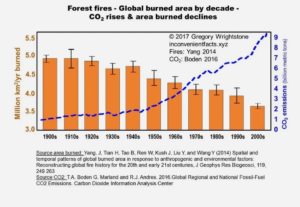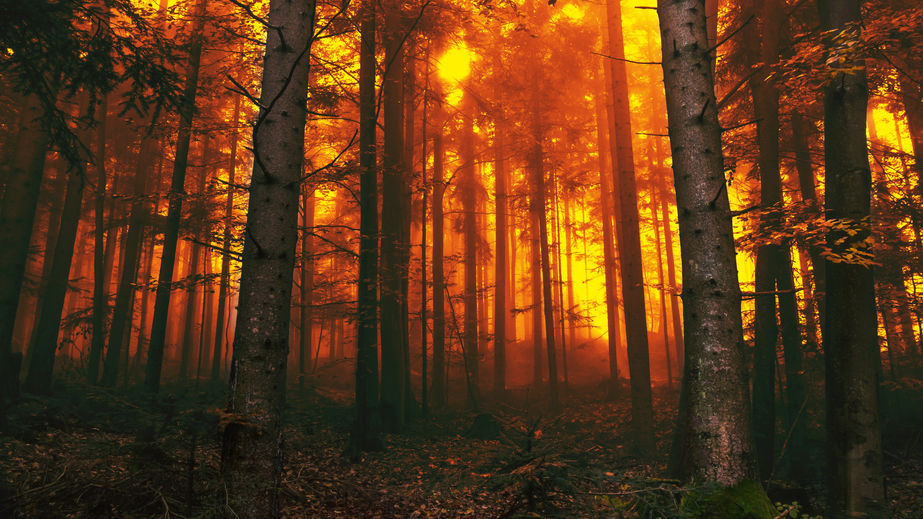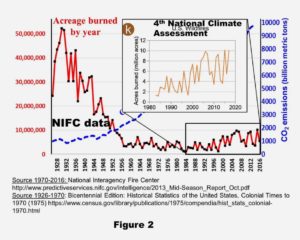The Union of Concerned Scientists are not necessarily scientists (anyone can join by paying a modest dues) and they certainly are not concerned about the lies they tell. Try this one: “The effects of global warming on temperature, precipitation levels, and soil moisture are turning many of our forests into kindling during wildfires”
Like many apocalyptic climate myths, there is wide acceptance among the media and the general public that forest fires are increasing in size and frequency due to global warming. Like the fatally flawed mathematical climate models the predictive equations for forest fires are equally absurd as the data will show.
A study by scientists with the Canadian Forest Service compared temperatures and carbon dioxide (CO2) concentrations versus frequency of forest fires over 150 years in North America and Northern Europe beginning in 1850. Not only did they not find a correlation between an increase in CO2 with an increase in forest fires they found a decrease in fires with an increase in CO2. This is illustrated in Figure 1 from the National Interagency Fire Center (NIFC) from 1962 to 2017.
I recommend using the NIFC chart going back to 1928:
One reason for the decline is an increase in worldwide soil moisture content that is partially due to increasing CO2. Higher CO2 levels mean that plants require less water, which remains in the soil.
A study performed in 2014 by Yang found that acreages burned worldwide in the 20th century and early 21st century had declined significantly as shown below in figure 2.
In spite of all the recent focus on the California forest fire tragedies and contrary to most public pronouncement, forest fires in his state are declining with the rest of the northern hemisphere. The United States Geological Survey’s fire scientist Jon Keeley checked the data for California back to 1920 and found that the number of forest fires peaked in the 1970s with a significant decrease since.
According to University of Washington scientist Cliff Mass, the number of fires in his state has been in a decades-long decline. Mass reports that between 1987 and 2016 fires declined by 50% although the areas burned have increased slightly.
In the early mid-20th century, sensible forest management included periodic timber harvests, tree thinning, controlled burns and grazing. Under the Clinton administration most of these activities were stopped in the name of having “naturally functioning ecosystems” which they ignorantly believed would protect old growth forests and spotted owls. The result has been more damage done per fire allowed due to increasing fuel-driven intensity. If you control the fuel, you control the fire.
In an interview with Evergreen magazine in 1994, forester Dr. Bob Zybach, warned that dead and dying material accumulating in forests in the west along with the decision to put out all wildfires, even when no human life was in danger, would lead to much greater wildfires in terms of their size. Eventually he predicted the potential loss of life we have seen in the past two years in California.
According to Gregory Wrightstone, in his climate science book INCONVENIENT FACTS the Sierra Nevada Conservancy, hardly a pro-logging group, explained that there are 300 to 400 trees per acre in western forest today where there had been only 50 to 80 trees when our forests were managed intelligently.This dense growth promotes the spread of bark beetles that leads to the death of trees which become kindling waiting for a spark to ignite them. The conservancy says “Fires that once revitalized forests are instead destroying them”.
It is important that we all understand the nature of forest fires to ensure we do not over-react to the misinformation provided by the media. The first ingredient of fires is an ignition source. According to University of Colorado ecologist Jennifer Batch, 84% of all fires in the United States are instigated by people. Not intentionally, but with some degree of carelessness. They include electric power lines, vehicle exhausts, smoking, motorized equipment such as lawnmowers and weed wackers and of course ARSON. With more homes encroaching on fire prone areas, it stands to reason that human caused ignition would increase. The USGS’s Jon Keeley calculated that homes at risk due to being in fire-prone areas in the west increased from about 600,000 in 1940 to nearly 7 million by 2010. This has dramatically increased the possibility for human ignition.
The media and alarmist groups tell one story while the data tell quite another. Rather than an increase in the frequency and intensity of forest fires, thanks to more carbon dioxide in the air, there has been as decrease. This is a very inconvenient fact for the ant-fossil fuel groups and the two men left vying for the Democratic nominee for President next fall.
Note: portions of this article were excerpted from the outstanding book INCONVENIENT FACTS with permission of the author Gregory Wrightstone. For detailed facts on the many facets of the climate change delusion, this book is highly recommended.

